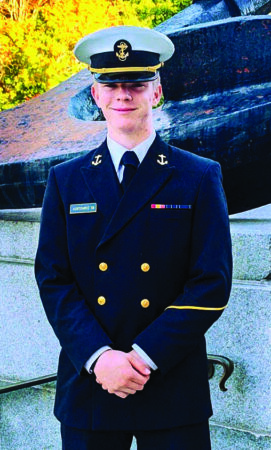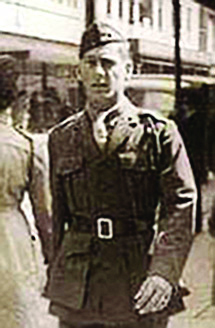- Carter Kostohryz, a 2022 Moorhead High graduate, is one of only two Moorhead men currently attending the U.S. Naval Academy.
- Carter Kostohryz’s great-grandfather, Donald Kostohryz, inspired his choice of a naval career. He served in the 2nd Marine Division in the Pacific during World War II.
Nancy Edmonds Hanson
When Carter Kostohryz was growing up in Moorhead, he heard tales of his great-grandfather’s service in the 2nd Marine Division, fighting in Guadalcanal and Tarawa during World War II. “He always said that experience was what made him the man he was,” the Moorhead High School graduate remembers.
Now 102-year-old Donald Kostohryz’s 20-year-old great-grandson is following in his footsteps, along with grandfathers, who served in the Army and Navy. He is one of only two young Moorhead men attending the U.S. Naval Academy.
“That was part of what got me interested in applying for the Academy,” he says. But only part: “As a kid, I was always interested in engineering things – toy boats and airplanes,” the young man says. “When I found out that was an actual college major that I could pursue there, I was hooked.”
So as his graduation loomed in 2022, Carter was drawn to the intersection of those two deep interests. He and his parents, Scott and Heather Kostohryz, traveled to Annapolis, Maryland, for Candidate Visit Weekend. There, he followed a freshman for a day through classes and activities. “I fell in love with Annapolis and the idea of military service and academics as a whole,” he says now. “I didn’t even visit another campus after that. I knew what I was going to do.”
Today, Carter is midway through the second year of his appointment to the Naval Academy. After interviews with U.S. Rep. Michelle Fischbach and Sens. Amy Klobuchar and Tina Smith, he was appointed by Fischbach, using one of her four allotted appointments.
He is one of only two Spuds on campus; the other is Jack Newcomb, who graduated in 2021. They’re a rarity in their class of 1,148 (down from the original cadre of 1,200 a year and one-half ago). “People from Moorhead just don’t apply. I don’t know of another in recent memory,” he says. “It’s too bad. They’re missing a fantastic opportunity.”
And a rigorous, demanding one. The Naval Academy, he reports, is “the pretty much the exact opposite of a party school.” His major is naval architecture and marine engineering. “The academics are tough,” he concedes.
Carter plans to spend the coming summers as a Plebe Summer detailer, one of the experienced students who guides 10 incoming first-year men and women through the seven-week version of basic training that introduces them to what they’re in for. “We’re held to three really high standards – moral, mental and physical,” he explains, adding that he himself was injured toward the end of his own experience: “It’s definitely tough, but I made it.”
About one-third of his class is made up of women, who have been part of the program since the 1980s. He rooms with two men, one from Duluth, Minnesota, the other from St. Louis, Missouri. Each is assigned to a host family in the Annapolis area, with whom they spend weekends getting to know the area.
Carter will complete his degree in 2026, starting his five-year commitment to the Navy with the rank of Ensign I. He’ll be promoted to Lieutenant Junior Grade after two years, then rise to the rank of Lieutenant during his fifth and final year. His ultimate goal, he says, is to join the Seabees, the Navy’s construction battalion. The Seabees provide a wide range of construction in support of operating forces, including roads, bridges, bunkers, airfields and logistics bases; disaster recovery operations; civic projects to improve relations with other nations; and anti-terrorism and force protection.
He strongly recommends that high school students consider the unconventional choice of applying for one of the country’s four military academies operated by the Army, Air Force, Merchant Marine and, of course, the Navy. Toward that end, he spent several days back home after Thanksgiving sharing their story with students at DGF, Park Christian and Moorhead High Schools. “It’s a tough challenge,” he told them. “But if you stick with it for four years, it sets you up for success in life.”
What’s been the biggest surprise at the Naval Academy? He cites friendships with not only fellow students but also his teachers, who range from civilian experts to high-ranking naval officers. “Our class size is about 18. You’re really close to your professors, and they’re always willing to help.
“They say you come to the Academy to serve your country and advance in your profession,” Carter muses. “But once you get here, you stay for the people.”




